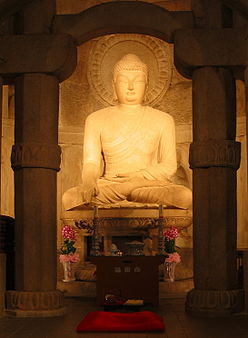Seokguram
| Seokguram Grotto and Bulguksa Temple | |
|---|---|
| Name as inscribed on the World Heritage List | |
 |
|
| Location | Republic of Korea |
| Type | Cultural |
| Criteria | i, iv |
| Reference | 736 |
| UNESCO region | Asia-Pacific |
| Inscription history | |
| Inscription | 1995 (19th Session) |
| Korean name | |
| Hangul | |
|---|---|
| Hanja | |
| Revised Romanization | Seokguram |
| McCune–Reischauer | Sŏkkuram |
The Seokguram Grotto is a hermitage and part of the Bulguksa temple complex. It lies four kilometers east of the temple on Mt. Tohamsan, in Gyeongju, South Korea. It is classified as National Treasure No. 24 by the South Korean government and is located at 994, Jinhyeon-dong, Gyeongju-si, Gyeongsanbuk-do. The grotto overlooks the East Sea (동해) and rests 750 meters above sea level. In 1962, it was designated the 24th national treasure of Korea. In 1995, Seokguram was added to the UNESCO World Heritage List together with the Bulguksa Temple. It exemplifies some of the best Buddhist sculptures in the world. [1]
It is said to have been built by Kim Daeseong and originally called Seokbulsa (석불사, Stone Buddha Temple). Construction began in 742 when Gim Daeseong resigned his position in the king's court or in 751, the 10th year of the reign of King Gyeongdeok of Silla. This time period was the cultural peak of Unified Silla. The grotto was completed by the Silla court in 774, shortly after Gim's death. An old legend stated that Gim was reincarnated for his filial acts in his previous life. The legend relates that the Bulguksa Temple was dedicated to Gim’s parents in his present life while the Seokguram Grotto was dedicated to Gim's parents from a previous life.
It is now one of the best known cultural destinations in South Korea. A viewing of the sunrise over the sea, which is visible from near the seated Buddha's perch, is especially popular.
India began a tradition of carving the image of Buddha in stone, holy images, and stupas into the cliff walls and natural caves. This practice was transferred to China and then Korea. The geology of the Korean Peninsula, which contains an abundance of hard granite, is not conducive to carving stone images into cliff walls. Seokguram is an artificial grotto made from granite and is unique in design. The small size of the grotto indicates that it was probably used exclusively by the Silla royalty.
...
Wikipedia
